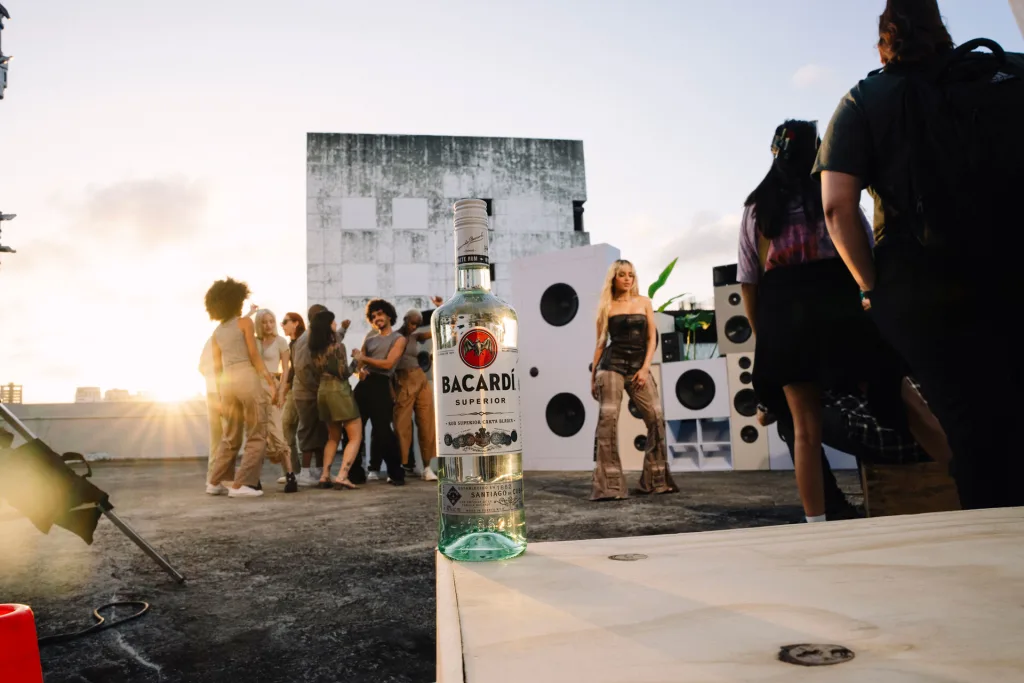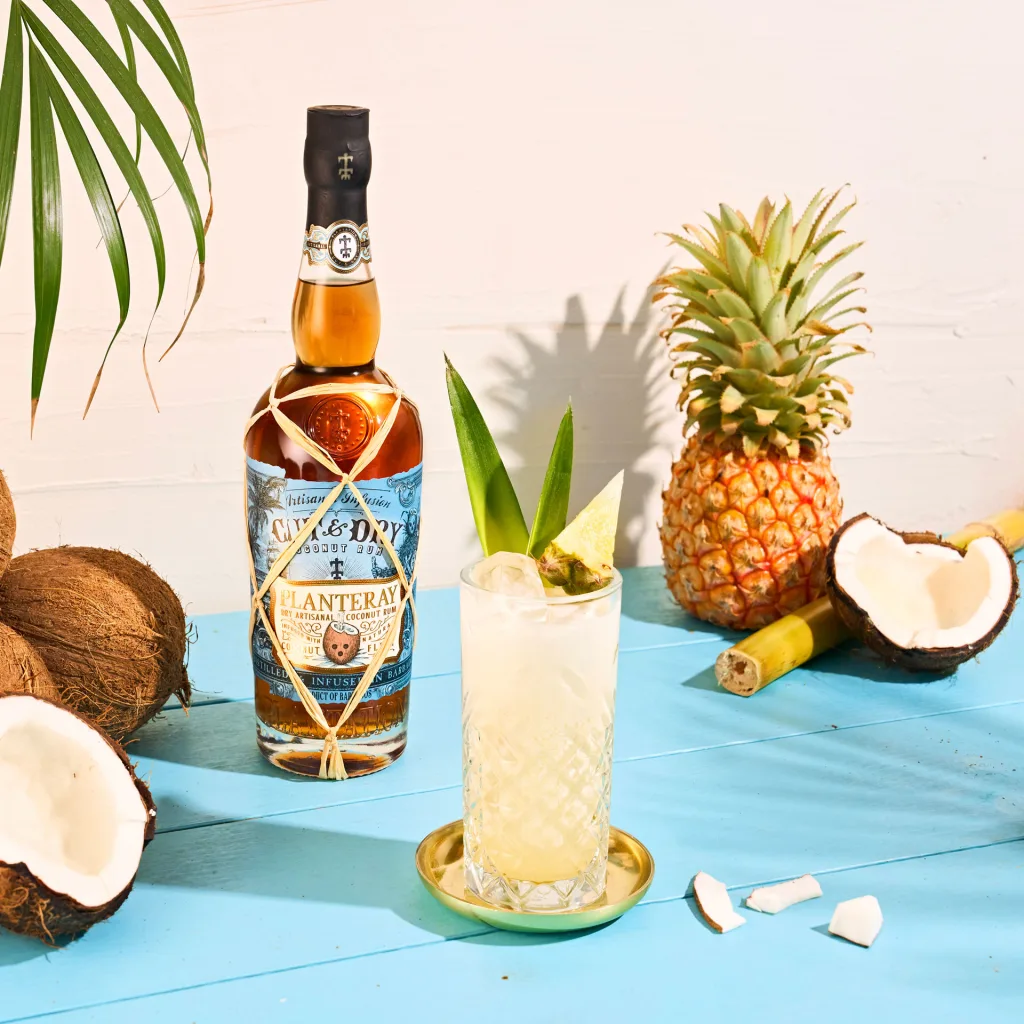At the Manhattan cocktail bar The Happiest Hour, Carlos Rodriguez is known to whip up cocktails that feature fresh flowers, bright green herbs, and contrasting colors in funky cocktail glassware that’s intended to allure the eye.
“People taste the cocktail first when they see it,” says Rodriguez, head bartender at the West Village watering hole. “We want to make sure everything is attractive.”
One of Happiest Hour’s biggest recent hits is a rum-based frozen daiquiri that features a peach gummy ring that serves as a garnish. It is indicative of the cocktail industry’s attempts to shake things up and generate some buzz for rum, a distilled alcoholic drink made from sugarcane juice or molasses.
In the U.S., rum generates $2.4 billion in revenue for distillers annually, reports the trade organization the Distilled Spirits Council of the U.S., known as DISCUS. But over the past decade or so, drinkers, primarily millennials, have been more drawn to tequila and whiskey, especially American-made bourbon and Irish whiskey.
Rum’s big problem
“Rum can easily hold its own with other spirits, it just has to be taken seriously and not dismissed,” says Nick Jackson, head bartender at The Rum House, a Times Square cocktail bar.
As Gen Z ages into the legal drinking category, rum producers have a fresh opportunity to make their sales pitch.
“We have this new generation of younger, Gen Z bartenders that are eager to showcase their craft,” says Alex Fellows, a senior brand manager at Brown-Forman, the producer of Jack Daniel’s whiskey which acquired the Diplomático Rum brand in 2023.
Fellows says cocktail purveyors have done some solid work introducing rum through popular cocktails like the mojito and pina daiquiri, or reinventing classics like the old fashioned, which is typically made with whiskey. But while Patrón, alongside some newer brands like Casamigos, helped reinvigorate tequila to become less about pounding shots and more about refined cocktails and sipping, rum has more work to do.
The hunt for a champion
“Rum is still waiting for that premium player to really invigorate rum,” says Fellows.
Across the spirits industry, category “champions” like Absolut, Patrón, and Maker’s Mark have elevated the prestige and pricing power for vodka, tequila, and bourbon, respectively. But rum has not yet produced a notable champion. Only 3% of rum sales volume in the U.S. are for “super premium” bottles, DISCUS data shows, bottles that sell for $30 or more. That badly lags behind American whiskey at 18% and Mexican-based tequila and mezcal, at a combined 25%.
Belizean-based Copalli Rum says some legacy producers built their brands on cheaper ingredients, like molasses, while he prefers to use sugar cane. “When you use better ingredients, you get a better product,” says David Bart, CEO at Copalli.
Copalli sells three different rum expressions, including a cacao rum that gives the rum a chocolate flavor that’s especially suitable for an espresso martini. All of the sugar cane and cacao that Copalli uses is grown and harvested on the brand’s property in the jungle in Belize. Copalli’s rums are also free of added flavors, colors, or additives, and Bart says future innovations will also come from ingredients found in the rainforest.
And while tequila has gotten a jolt from a slew of celebrity-endorsed brands ranging from actor George Clooney to model Kendall Jenner, Bart says rum producers should focus their messaging more on heritage and quality ingredients. “We’re not banking on hiring a huge celebrity to promote our brand,” he says. “I think that’s a little passe.”
A marketing challenge
Bacardi isn’t as fearful of linking rums to pop culture. To solidify the brand’s relationship with Gen Z drinkers, it partnered with singer Camila Cabello and created a digital video featuring her song “I LUV IT.” There’s even a Cabello crafted Bacardi cocktail, a rum punch with Bacardi, passion fruit, and St-Germain liqueur.

Singers have been particularly enticed by rum. Bruno Mars, Ciara, and Kenny Chesney have all backed rum brands. Those offerings, as well as a slew of new entrants into the category, have created a more competitive market for rum, says Bacardi.
“These challenges also present exciting opportunities,” says Lisa Pfenning, vice president of Bacardi’s rum portfolio in the Americas. She says rum can benefit from increased consumer awareness of the liquor’s versatility. One of Bacardi’s newest offerings, the citrus-forward Sevillian Orange Cask Finish, was created to blend in cocktails or be enjoyed as a sippable spirit.
Rum brand Planteray blends rums that are made from 16 different countries, ranging from Jamaica to Paraguay. Newer launches include a rum infused with pineapple or coconut. Some rums result from a blend of stocks from different regions across the globe. Planteray’s Sealander is blended from rums produced in Fiji, Barbados, and Mauritius.
“We really want to give people that beautiful, tropical aromatics, in particular, aromatics of cane and molasses,” says Guillaume Lamy, managing director of the North American market for alcoholic beverage producer Maison Ferrand.
Planteray finds inspiration from rum’s diversity, noting that even within the same country, the flavors can develop in unique ways. In Jamaica, as an example, rums from the south tend to be lighter than those made in the north. “That’s the beauty of rum,” says Lamy.

That diversity may also pose a bit of a marketing challenge. Rum is imported from more than 50 countries, ranging from heavy hitters like Jamaica, Barbados, and Guatemala and lesser known rums from Suriname, Argentina, and the Bahamas. Unlike tequila and cognac, which are only produced in Mexico and France, respectively, rum’s story can be a bit more muddled given all the different approaches to distilling, aging, and flavors.
“It forces us to have people think about rum differently,” says Bart. “It can be made anywhere.”
Rum is also made in the United States, where Parlor Cay Rum is based. Launched in 2022, it distills rum from Gulf Coast sugar cane molasses from several states including Alabama and Texas.
“We’re trying to remind people of the craftsmanship and the agricultural heritage of America,” says Alfred English, CEO of Sespe Creek Distillery.
